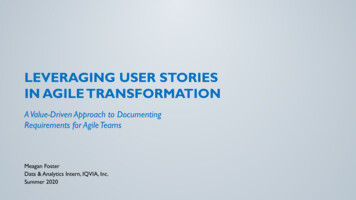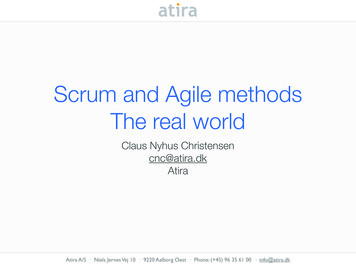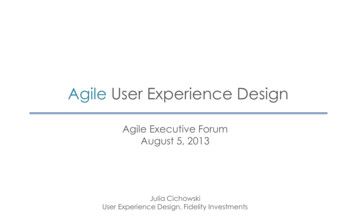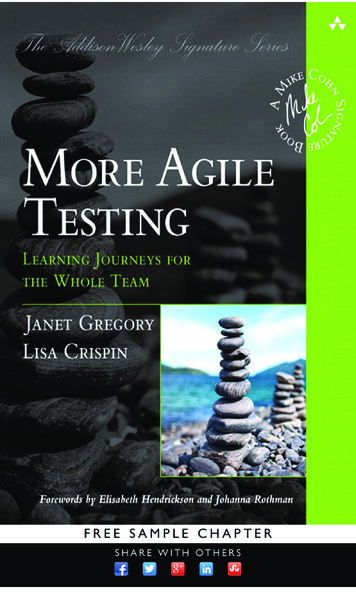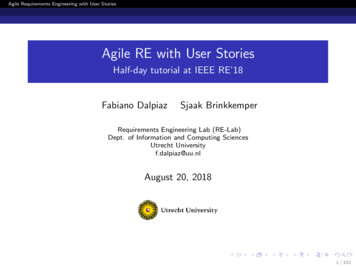
Transcription
Agile Requirements Engineering with User StoriesAgile RE with User StoriesHalf-day tutorial at IEEE RE’18Fabiano DalpiazSjaak BrinkkemperRequirements Engineering Lab (RE-Lab)Dept. of Information and Computing SciencesUtrecht Universityf.dalpiaz@uu.nlAugust 20, 20181 / 102
Agile Requirements Engineering with User StoriesPreliminariesTable of Contents1 Preliminaries2 Agile RE and User Stories: fundamentals3 The Quality User Story framework4 Extracting conceptual models5 Taming ambiguity and incompleteness6 Wrap up2 / 102
Agile Requirements Engineering with User StoriesPreliminariesOn this tutorialSpoiler alert!Four parts1Agile RE and user stories: fundamentals2The Quality User Story framework3Extracting conceptual models4Taming ambiguity and incompleteness3 / 102
Agile Requirements Engineering with User StoriesPreliminariesOn this tutorialSpoiler alert!Four parts1Agile RE and user stories: fundamentals2The Quality User Story framework3Extracting conceptual models4Taming ambiguity and incompletenessInteraction, also via hands-on activities3 / 102
Agile Requirements Engineering with User StoriesPreliminariesLiteratureKey papers behind this tutorialGarm Lucassen, Fabiano Dalpiaz, Jan Martijn E.M. van der Werf, and SjaakBrinkkemper, Improving agile requirements: the Quality User Story frameworkand tool, Requirements Engineering 21 (2016), no. 3, 383–403Garm Lucassen, Marcel Robeer, Fabiano Dalpiaz, Jan Martijn E. M. van derWerf, and Sjaak Brinkkemper, Extracting conceptual models from user storieswith Visual Narrator, Requirements Engineering 22 (2017), no. 3, 339–358Fabiano Dalpiaz, Ivor van der Schalk, and Garm Lucassen, PinpointingAmbiguity and Incompleteness in Requirements Engineering via InformationVisualization and NLP, Proceedings of the 24th International WorkingConference on Requirements Engineering: Foundation for Software Quality(REFSQ’18), 20184 / 102
Agile Requirements Engineering with User StoriesPreliminariesWho are we?Dr. Fabiano DalpiazAssistant professor in Requirements Engineeringat Utrecht UniversityArtificial Intelligence (NLP and more) for RECrowd Requirements EngineeringEngaging the stakeholders via gamesModeling languagesLocal organizer of REFSQ 2018!http://www.staff.science.uu.nl/ dalpi001/5 / 102
Agile Requirements Engineering with User StoriesPreliminariesWho are we?Prof.dr. Sjaak BrinkkemperProfessor in Software Productionat Utrecht UniversityResearch group of 35 staff and PhDsProduct Software: Methodology ofDevelopment, Implementation,and r/06 / 102
Agile Requirements Engineering with User StoriesPreliminariesWho are you?NameOrganizationRoleExperience with user storiesWhat do you expect to learn from this tutorial?7 / 102
Agile Requirements Engineering with User StoriesPreliminariesCreditsThese slides are partially based on the slides by Garm Lucassen and SjaakBrinkkemper presented at earlier tutorials and in professional courses.8 / 102
Agile Requirements Engineering with User StoriesPreliminariesFollow the slidesDownload these slides from the following URL:https://bit.ly/2OPqiCL9 / 102
Agile Requirements Engineering with User StoriesPreliminariesTable of Contents1 Preliminaries2 Agile RE and User Stories: fundamentals3 The Quality User Story framework4 Extracting conceptual models5 Taming ambiguity and incompleteness6 Wrap up10 / 102
Agile Requirements Engineering with User StoriesAgile RE and User Stories: fundamentalsTable of Contents1 Preliminaries2 Agile RE and User Stories: fundamentals3 The Quality User Story framework4 Extracting conceptual models5 Taming ambiguity and incompleteness6 Wrap up11 / 102
Agile Requirements Engineering with User StoriesAgile RE and User Stories: fundamentalsWhat is agile RE?An informal definitionAgile RE [ISM 15]The term “agile requirements engineering” is used to define the “agileway” of planning, executing and reasoning about requirementsengineering activities.12 / 102
Agile Requirements Engineering with User StoriesAgile RE and User Stories: fundamentalsAgile RE vs. Traditional REResults from a systematic literature review [ISM 15]Seventeen practices of agile RE have been studied in the literature:13 / 102
Agile Requirements Engineering with User StoriesAgile RE and User Stories: fundamentalsAgile RE vs. Traditional REChallenges resolved by agile RE practicesCommunication issuesFrequent face-to-face meeting with the customer and among teamsCollocated teams for better collaborationOnsite customer as opposed to contractsAlternate customer representations (proxy customers)Cross-functional agile teamsIntegrated RE process, closer to development14 / 102
Agile Requirements Engineering with User StoriesAgile RE and User Stories: fundamentalsAgile RE vs. Traditional REChallenges resolved by agile RE practicesOverscopingOne continuous scope flow via continuous prioritizationGradual detailing of requirementsCross-functional teams that share responsibilities15 / 102
Agile Requirements Engineering with User StoriesAgile RE and User Stories: fundamentalsAgile RE vs. Traditional REChallenges resolved by agile RE practicesOverscopingOne continuous scope flow via continuous prioritizationGradual detailing of requirementsCross-functional teams that share responsibilitiesRequirements validationRequirements prioritization done by the customer picking the mostimportant requirementsPrototyping that provide a product blueprint15 / 102
Agile Requirements Engineering with User StoriesAgile RE and User Stories: fundamentalsAgile RE vs. Traditional REChallenges resolved by agile RE practicesRequirements documentationUser stories are precise, to-the-point, and prevent the need for longSRS documents that are hard to updateFace-to-face communication helps reduce ambiguities16 / 102
Agile Requirements Engineering with User StoriesAgile RE and User Stories: fundamentalsAgile RE vs. Traditional REChallenges resolved by agile RE practicesRequirements documentationUser stories are precise, to-the-point, and prevent the need for longSRS documents that are hard to updateFace-to-face communication helps reduce ambiguitiesRare customer involvementRequirements prioritization is done by the customer16 / 102
Agile Requirements Engineering with User StoriesAgile RE and User Stories: fundamentalsAgile RE vs. Traditional REOpen challenges (1/2)Minimal documentation: user stories and backlogs Poor traceabilityHigh customer availability is demanded When impossible, increased rework17 / 102
Agile Requirements Engineering with User StoriesAgile RE and User Stories: fundamentalsAgile RE vs. Traditional REOpen challenges (1/2)Minimal documentation: user stories and backlogs Poor traceabilityHigh customer availability is demanded When impossible, increased reworkInappropriate architecture due to agility Increased costBudget and time estimations affected by continuous changes Project delays17 / 102
Agile Requirements Engineering with User StoriesAgile RE and User Stories: fundamentalsAgile RE vs. Traditional REOpen challenges (2/2)Customer inability and lack of agreement Increased reworkContractual limitations hindering change Increased costRequirements change and its consequence Work delays18 / 102
Agile Requirements Engineering with User StoriesAgile RE and User Stories: fundamentalsYour experience with user storiesHow would you describe them as requirements?19 / 102
Agile Requirements Engineering with User StoriesAgile RE and User Stories: fundamentalsWhat is a user story?Some examplesAs a visitor, I want to purchase an event ticket20 / 102
Agile Requirements Engineering with User StoriesAgile RE and User Stories: fundamentalsWhat is a user story?Some examplesAs a visitor, I want to purchase an event ticketAs a visitor, I want to search for new events by favorited organizers,so that I am the first to know of new events20 / 102
Agile Requirements Engineering with User StoriesAgile RE and User Stories: fundamentalsWhat is a user story?Some examplesAs a visitor, I want to purchase an event ticketAs a visitor, I want to search for new events by favorited organizers,so that I am the first to know of new eventsAs a visitor, I want to be notified when an event is close tobecoming sold out, so that I do not miss the event20 / 102
Agile Requirements Engineering with User StoriesAgile RE and User Stories: fundamentalsWhat is a user story?ConceptualizationAs a hrolei, I want to hactioni, (so that hbenefiti)21 / 102
Agile Requirements Engineering with User StoriesAgile RE and User Stories: fundamentalsWhat is a user story?ConceptualizationAs a hrolei, I want to hactioni, (so that hbenefiti)User stories only capture the essential elements of a requirementwho it is forwhat s/he expects from the systemwhy it is important (optional?)21 / 102
Agile Requirements Engineering with User StoriesAgile RE and User Stories: fundamentalsWhat is a user story?GuidelinesDon’t force a story into its format when unnaturalBusiness/domain/application jargonNo technical details22 / 102
Agile Requirements Engineering with User StoriesAgile RE and User Stories: fundamentalsWhat is a user story?GuidelinesDon’t force a story into its format when unnaturalBusiness/domain/application jargonNo technical detailsAs a researcher,I want to receive new paper notifications,so that I can write a good literature review22 / 102
Agile Requirements Engineering with User StoriesAgile RE and User Stories: fundamentalsWhat is a user story?GuidelinesDon’t force a story into its format when unnaturalBusiness/domain/application jargonNo technical detailsAs a researcher,I want to receive new paper notifications,so that I can write a good literature review22 / 102
Agile Requirements Engineering with User StoriesAgile RE and User Stories: fundamentalsHistoryFirst mention in Kent Beck’s 1999 book “Extreme ProgrammingExplained”Unstructured textSimilar to use casesRestricted in sizeJeffries 2001: card, conversation, confirmation23 / 102
Agile Requirements Engineering with User StoriesAgile RE and User Stories: fundamentalsHistoryFirst mention in Kent Beck’s 1999 book “Extreme ProgrammingExplained”Unstructured textSimilar to use casesRestricted in sizeJeffries 2001: card, conversation, confirmationWidespread popularity: Mike Cohn’s “User Stories Applied” (2004)23 / 102
Agile Requirements Engineering with User StoriesAgile RE and User Stories: fundamentalsSome evidence of their popularityResults from academic studies45% of practitioners employ user stories [Kas15]In agile development, adoption is up to 90% [WZWS14]24 / 102
Agile Requirements Engineering with User StoriesAgile RE and User Stories: fundamentalsSome evidence of their popularityResults from academic studies45% of practitioners employ user stories [Kas15]non templateIn agile development, adoption is up to 90% [WZWS14]1. Productivity11%37%52%Practitioners’ perception of impact is positive [LDvdWB16a]2. Quality15%3. Productivity template33%4. Quality template37%33%S1. Productivity8%S2. Quality9%22%14%S4. Quality template13%guidelines15%6. Quality guidelinesS5. Productivity10%S6. Quality guidelines7%Strongly 48%41%S3. Productivity templateProductivity guidelines37%52%31%Disagree48%52%PercentageNeither Agree nor DisagreeAgreeStrongly Agree24 / 102
Agile Requirements Engineering with User StoriesAgile RE and User Stories: fundamentalsExercise #1Your taskForm groups of twoUse a sheet of paper or a text editorWrite at least 10 user stories for a conference management systemAbout 10 minutes!25 / 102
Agile Requirements Engineering with User StoriesAgile RE and User Stories: fundamentalsExercise #1ReviewExercise evaluationLet us discuss a few user stories!What are the key roles?26 / 102
Agile Requirements Engineering with User StoriesAgile RE and User Stories: fundamentalsExercise #1ReviewExercise evaluationLet us discuss a few user stories!What are the key roles?Discussion triggersIs the role the actual role?Did you specify the why part?Have you forced the text into the format?Did you use domain jargon?Are there technical details?26 / 102
Agile Requirements Engineering with User StoriesThe Quality User Story frameworkTable of Contents1 Preliminaries2 Agile RE and User Stories: fundamentals3 The Quality User Story framework4 Extracting conceptual models5 Taming ambiguity and incompleteness6 Wrap up27 / 102
Agile Requirements Engineering with User StoriesThe Quality User Story frameworkINVESTThe state of the practiceSeveral organizations use the INVEST framework – Bill Wake 2003Independent: minimize dependencies between user storiesNegotiable: details are discussed in the iteration planning meetingsValuable to the customerEstimable: detailed enough to allow effort estimationSmall in effortTestable with certain acceptance criteria28 / 102
Agile Requirements Engineering with User StoriesThe Quality User Story frameworkINVESTThe state of the practiceSeveral organizations use the INVEST framework – Bill Wake 2003Independent: minimize dependencies between user storiesNegotiable: details are discussed in the iteration planning meetingsValuable to the customerEstimable: detailed enough to allow effort estimationSmall in effortTestable with certain acceptance criteriaUseful, but hard to operationalize!28 / 102
Agile Requirements Engineering with User StoriesThe Quality User Story frameworkUnderstanding user storiesAn approach based on linguistics jectAction 1RoleQuality0.*11.*1User Story0.*1Format1.*hasEpic29 / 102
Agile Requirements Engineering with User StoriesThe Quality User Story frameworkUnderstanding user storiesApplying the conceptual model, high-level analysisAs a hresearcherirole ,I want to hreceive new paper notificationsimeans ,so that hI can write a good literature reviewiendMeansEnd1has parent0.1110.*1.*Role11.*User Story1Format30 / 102
Agile Requirements Engineering with User StoriesThe Quality User Story frameworkUnderstanding user storiesApplying the conceptual model, IndirectObject31 / 102
Agile Requirements Engineering with User StoriesThe Quality User Story frameworkUnderstanding user storiesApplying the conceptual model, IndirectObject“I want to receive new paper notifications”31 / 102
Agile Requirements Engineering with User StoriesThe Quality User Story frameworkUnderstanding user storiesApplying the conceptual model, bjectAdjective“I want to receive new paper notifications” hIirole want to hreceiveiaction hnewiadjective hpaper notificationsid -object31 / 102
Agile Requirements Engineering with User StoriesThe Quality User Story frameworkUnderstanding user storiesApplying the conceptual model, endThe end may represent one or more of the following:A clarification of the meansA quality aspectA dependency on another user story32 / 102
Agile Requirements Engineering with User StoriesThe Quality User Story frameworkUnderstanding user storiesApplying the conceptual model, endThe end may represent one or more of the following:A clarification of the meansA quality aspectA dependency on another user story“so that I can write a good literature review”32 / 102
Agile Requirements Engineering with User StoriesThe Quality User Story frameworkUnderstanding user storiesApplying the conceptual model, endThe end may represent one or more of the following:A clarification of the meansA quality aspectA dependency on another user story“so that I can write a good literature review” hI can write a hgoodiquality hliterature reviewidependency iclarification32 / 102
Agile Requirements Engineering with User StoriesThe Quality User Story frameworkQuality problems in practiceRegardless of INVESTThe conceptual model captures correct storiesIn practice, however, storiesAre too longInclude unnecessary informationInclude too little informationAre inconsistentAre irrelevant for the software to-beContain ambiguity33 / 102
Agile Requirements Engineering with User StoriesThe Quality User Story frameworkThe Quality User Story FrameworkOverviewBased on the critical analysis of hundreds of user storiesIncludes insights from other frameworks such as y freeUser Story QualityFull ntComplete34 / 102
Agile Requirements Engineering with User StoriesThe Quality User Story frameworkThe Quality User Story FrameworkQuality of individual y soundProblem-orientedUnambiguousFull sentenceEstimableDescriptionIncludes at least a role and a meansExpresses a requirement for exactly one featureContains nothing more than role, means and endsThe means expresses a feature and the ends a rationaleOnly specifies the problem, not the solution to itAvoids terms that lead to multiple interpretationsIs a well-formed full sentenceDoes not denote an unrefined requirement that is difficultto plan and prioritize35 / 102
Agile Requirements Engineering with User StoriesThe Quality User Story frameworkThe Quality User Story FrameworkQuality of user story ompleteDescriptionThere should not be 2 inconsistent user storiesDuplicates shall be avoidedAll user stories in a specification employ the same templateA user story is self-contained and has no inherent dependencieson other storiesImplementing a set of user stories creates a feature-completeapplication, no steps are missing36 / 102
Agile Requirements Engineering with User StoriesThe Quality User Story frameworkQUS in practiceA first set of criteriaDon’t consider all criteria upfront!Focus on1234567Well-formedAtomicMinimalConceptually soundProblem orientedFull sentenceUniform37 / 102
Agile Requirements Engineering with User StoriesThe Quality User Story frameworkQUS in practice1. Well-formedWell-formedA user story includes at least a role and an actionExample (Violation)I want to revoke access to problematic event organizers38 / 102
Agile Requirements Engineering with User StoriesThe Quality User Story frameworkQUS in practice1. Well-formedWell-formedA user story includes at least a role and an actionExample (Violation)I want to revoke access to problematic event organizers (add role)As a TicketExpert Employee, I want to revoke access to problematicevent organizers38 / 102
Agile Requirements Engineering with User StoriesThe Quality User Story frameworkQUS in practice2. AtomicAtomicA user story expresses a requirement for exactly one feature/problemExample (Violation)As a Visitor, I want to register for an event and create a personalaccount, so that I can quickly register for future events39 / 102
Agile Requirements Engineering with User StoriesThe Quality User Story frameworkQUS in practice2. AtomicAtomicA user story expresses a requirement for exactly one feature/problemExample (Violation)As a Visitor, I want to register for an event and create a personalaccount, so that I can quickly register for future events (split)1As a Visitor, I want to register for an event, so that I am admittedto the event2As a Visitor, I want to create a personal account during eventregistration, so that I can quickly register for future events39 / 102
Agile Requirements Engineering with User StoriesThe Quality User Story frameworkQUS in practice3. MinimalMinimalA user story contains nothing more than role, action and benefitExample (Violation)As an Event Organizer, I want to see the personal information ofattendees (split into price levels). See: Mockup by Alice NOTE: - Firstcreate the overview screen40 / 102
Agile Requirements Engineering with User StoriesThe Quality User Story frameworkQUS in practice3. MinimalMinimalA user story contains nothing more than role, action and benefitExample (Violation)As an Event Organizer, I want to see the personal information ofattendees (split into price levels). See: Mockup by Alice NOTE: - Firstcreate the overview screen (remove unnecessary information)As an Event Organizer, I want to see the personal information ofattendees40 / 102
Agile Requirements Engineering with User StoriesThe Quality User Story frameworkQUS in practice4. Conceptually soundConceptually soundThe action expresses a feature and the benefit expresses a rationaleExample (Violation)As an Event Organizer, I want to open the event page, so that I can seethe personal information of attendees41 / 102
Agile Requirements Engineering with User StoriesThe Quality User Story frameworkQUS in practice4. Conceptually soundConceptually soundThe action expresses a feature and the benefit expresses a rationaleExample (Violation)As an Event Organizer, I want to open the event page, so that I can seethe personal information of attendees (end becomes a separate means)1As an Event Organizer, I want to open the event page, so that I canreview event related information2As a User, I want to see personal information of attendees, so that Iknow the demographical distribution of the event41 / 102
Agile Requirements Engineering with User StoriesThe Quality User Story frameworkQUS in practice5. Problem orientedProblem orientedA user story only specifies the problem, not the solution to itExample (Violation)As a Visitor, I want to download an event ticket. - Add download buttonon top right (never grayed out)42 / 102
Agile Requirements Engineering with User StoriesThe Quality User Story frameworkQUS in practice5. Problem orientedProblem orientedA user story only specifies the problem, not the solution to itExample (Violation)As a Visitor, I want to download an event ticket. - Add download buttonon top right (never grayed out) (remove solution)As a Visitor, I want to download an event ticket42 / 102
Agile Requirements Engineering with User StoriesThe Quality User Story frameworkQUS in practice6. Full sentenceFull sentenceA user story is a well-formed full sentenceExample (Violation)update profile43 / 102
Agile Requirements Engineering with User StoriesThe Quality User Story frameworkQUS in practice6. Full sentenceFull sentenceA user story is a well-formed full sentenceExample (Violation)update profile (add ‘want to’)As a Visitor, I want to update my profile43 / 102
Agile Requirements Engineering with User StoriesThe Quality User Story frameworkQUS in practice7. UniformUniformAll user stories follow (roughly) the same templateExample (Violation)1As a Visitor, I want to create an account2As a Visitor, I want to reset my password3As a TicketExpert Manager, I receive an email notification when anew user is registered44 / 102
Agile Requirements Engineering with User StoriesThe Quality User Story frameworkQUS in practice7. UniformUniformAll user stories follow (roughly) the same templateExample (Violation)1As a Visitor, I want to create an account2As a Visitor, I want to reset my password3As a TicketExpert Manager, I receive an email notification when anew user is registered (add ‘want to’)As an TicketExpert Manager, I want to receive an email notificationwhen a new user is registered44 / 102
Agile Requirements Engineering with User StoriesThe Quality User Story frameworkThe AQUSA toolThe Automatic Quality User Story ArtisanTool developed at UU: www.aqusa.nlAutomatically assesses user story quality according to QUSFocus on those criteria with potential for 100% recallWell-formedAtomicMinimalExplicit erUser inimalIndependentUniformUnique45 / 102
Agile Requirements Engineering with User StoriesThe Quality User Story frameworkExercise #2Analyze a set of user storiesOpen https://bit.ly/2nyvb7Q with your browserManually explore the output of the AQUSA toolTry to identify similar defects in the user stories that you wrote10-15 minutes!46 / 102
Agile Requirements Engineering with User StoriesThe Quality User Story frameworkExercise #2ReviewExercise evaluationWhat were the most common mistakes?What is their impact?How do your own stories compare to the data set?Do you agree with the fixes that are suggested?47 / 102
Agile Requirements Engineering with User StoriesThe Quality User Story frameworkEstimating and developingApplying the other criteriaAfter initial fixes to sanitize the user stories, the other criteriabecome eIndependentUniqueComplete48 / 102
Agile Requirements Engineering with User StoriesThe Quality User Story frameworkEstimating and developingApplying the other criteriaAfter initial fixes to sanitize the user stories, the other criteriabecome eIndependentUniqueCompleteWe focus only on some of these criteria today48 / 102
Agile Requirements Engineering with User StoriesThe Quality User Story frameworkQUS in practice: improving the user stories8. UnambiguousUnambiguousA user story avoids terms that lead to multiple interpretationsExample (Violation)As an Event Organizer, I want to edit the content that I added to anevent’s page49 / 102
Agile Requirements Engineering with User StoriesThe Quality User Story frameworkQUS in practice: improving the user stories8. UnambiguousUnambiguousA user story avoids terms that lead to multiple interpretationsExample (Violation)As an Event Organizer, I want to edit the content that I added to anevent’s page (clarify the term “content”)As an Event Organizer, I want to edit video and text content that Iadded to an event’s page49 / 102
Agile Requirements Engineering with User StoriesThe Quality User Story frameworkQUS in practice: improving the user stories8. UnambiguousUnambiguousA user story avoids terms that lead to multiple interpretationsExample (Violation)As an Event Organizer, I want to edit the content that I added to anevent’s page (clarify the term “content”)As an Event Organizer, I want to edit video and text content that Iadded to an event’s pageMore on ambiguity in the fourth part of the tutorial!49 / 102
Agile Requirements Engineering with User StoriesThe Quality User Story frameworkQUS in practice: improving the user stories12. IndependentIndependentA user story is self-contained and has no inherent dependencies on otherstoriesExample (Violation)1As an Event Organizer, I am able to add a new event2As a Visitor, I am able to view an event page50 / 102
Agile Requirements Engineering with User StoriesThe Quality User Story frameworkQUS in practice: improving the user stories12. IndependentIndependentA user story is self-contained and has no inherent dependencies on otherstoriesExample (Violation)1As an Event Organizer, I am able to add a new event2As a Visitor, I am able to view an event page No solution here!It is not always possible for user stories to be fully independentAvoid dependencies as much as possible, but be flexible!50 / 102
Agile Requirements Engineering with User StoriesThe Quality User Story frameworkQUS in practice: improving the user stories13. CompleteCompleteImplementing a set of user stories creates a feature-complete application,no steps are missingExample (Violation)1As an Event Organizer, I want to update an event2As an Event Organizer, I want to delete an event51 / 102
Agile Requirements Engineering with User StoriesThe Quality User Story frameworkQUS in practice: improving the user stories13. CompleteCompleteImplementing a set of user stories creates a feature-complete application,no steps are missingExample (Violation)1As an Event Organizer, I want to update an event2As an Event Organizer, I want to delete an event (add story)As an Event Organizer, I want to create an event51 / 102
Agile Requirements Engineering with User StoriesThe Quality User Story frameworkExercise #3Further improve your user storiesTake a look at the user stories you have writtenCheck them against the additional criteria123UnambiguousIndependentComplete10 minutes!52 / 102
Agile Requirements Engineering with User StoriesThe Quality User Story frameworkExercise #3ReviewExercise evaluationWhich was the most common defect?How simple was the task at hand?Share some examples!Any1 doubts?1 . . . ormany53 / 102
Agile Requirements Engineering with User StoriesExtracting conceptual modelsTable of Contents1 Preliminaries2 Agile RE and User Stories: fundamentals3 The Quality User Story framework4 Extracting conceptual models5 Taming ambiguity and incompleteness6 Wrap up54 / 102
Agile Requirements Engineering with User StoriesExtracting conceptual modelsOK, so you’ve got a set of sanitized user storiesAdditional obstaclesAs development goes on, the number of user stories increase55 / 102
Agile Requirements Engineering with User StoriesExtracting conceptual modelsOK, so you’ve got a set of sanitized user storiesAdditional obstaclesAs development goes on, the number of user stories increaseHow to get a holistic view?55 / 102
Agile Requirements Engineering with User StoriesExtracting conceptual modelsOK, so you’ve got a set of sanitized user storiesAdditional obstaclesAs development goes on, the number of user stories increaseHow to get a holistic view?Team members leave, and take away their know-how55 / 102
Agile Requirements Engineering with User StoriesExtracting conceptual modelsOK, so you’ve got a set of sanitized user storiesAdditional obstaclesAs development goes on, the number of user stories increaseHow to get a holistic view?Team members
Agile Requirements Engineering with User Stories Preliminaries On this tutorial Spoiler alert! Four parts 1 Agile RE and user stories: fundamentals 2 The Quality User Story framework 3 Extracting conceptual models 4 Taming ambiguity and



